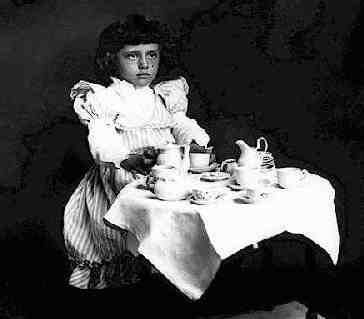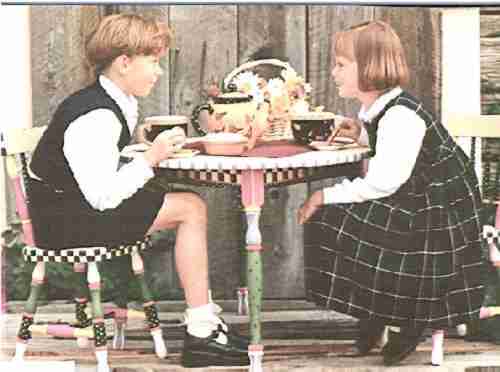
Figure 1.--This little girl, probably in the 1890s, is having a tea party. Note the pinafore she wears over her dress.


Figure 1.--This little girl, probably in the 1890s, is having a tea party. Note the pinafore she wears over her dress. |
One of the hallmarks of the Victorian and Edwardian
nursery was the tea party. In part this was a reflection of social engagements of the day. Affluent women loved to have friends over for afternoon tea where they could discuss their husbands and children, fashion,
music and theater, and the latest gosip. Children in the nursery of course emulated their parents, and were probably encouraged to do so by their nannies. Tea parties are much less common in our modern more hurries modern era.
Victorian and Edwardian little girls outfitted in smocks or emaculate starched white pinafores held endless mock tea parties. Of course it was the girls who were primarily interested in tea parties. However, they often involved their brothers-- especially if they had younger brothers still in the nursery. Little brothers pobably also attired in smocks and pinafores probably cooperated willingly. Older brothers may have had to be drafted by nanny. Even boys without sisters were often incouraged to have mock tea parties as part of the process of teaching manners and deportment. The outfits worn by these children is probably a good reflection of nursery fashion.
The tea party of course even appeared as a main scene in the
Victorian classic by Lewis Carol, Alice in Worderland. Is there
anyone who has not rejoiced in the topsy-turvy
adventures of pinafore-clad Alice in her Wonderland adventures?
Understanfing tea parties is a little difficult for modern readers as tea parties are so infrequent in our modern age. They were much more common in the era when wealthy women rarely worked. Afternoon teas with friends was an important social institution. Thus play teas was an important way of little girls learning the manners appropriate for these parties. And of course their brothers needed to learn the appropriate probietis as well.
Boys were not always the most excited participants in these tea parties. However it must have been a bit dull in the confined nurseries of the Victorian and Edwardian nursery. Without radio and later television, not to mention video ganmes, many children must have been a bit bored. In addition suggestions by nanny and mother must have cairred more weight. Thus boys probably participated in tea parties much more often in the past than is the case today.
This has not entirely disappeared even today. Toy
stores even in America where tea is not commonly drunk usually have little girl tea sets. Rare is the little girl who doesn't love a tea party. Although nanny is no longer around to dragoon her brother into the affair. There's just something magical for little girls
about those little china cups, petit fours and lace
tablecloths.

Figure 3.--. |
Girls have almost always been more interested in tea parties than boys. This is especially true in our modern age. Often girls will have play tea parties among themselves to practice their manners. Most boys will generally not be to excited about participating. This has traditiinally been the case as did England's Just William when invited by Violet Elizabeth Bott or America's Dennis the Menance when invited by Margaret. Some sisters with younger brothers or very persuasive young ladies may convince boys to participate, perhaps with a little encouragement from mother. However today, long freed from the confines of the nursery, it is likely to be a tough sell for even the most persuasive young lady.
The nostalgic memories of tea parties long gone are still remembered by the modern mother. One imaginative entrpreneur has even franchised a tea party business to help mothers recreate the elegance of a former
era. She tells interested investors, "This imaginative children's
birthday party business will create a lasting memory for your
customers by incorporating elegant costuming,
old fashioned games and nostalgic photography in a relaxed tea party
atmosphere that carries everyone back to a time less hurried."
Many hotels now offer children's teas. The little ones have to
brush up on their P's and Q's and dress in their best dress, perhaps
even adding a fancy pinafore for the occasion for an elegant afternoon.
One San Diego hotel advertises:
Step right into the pages of a Jane Austen novel with a visit to the gracious U.S. Grant Hotel in the heart of San Diego. You can almost hear the rustle of petticoats while taking tea amid the lobby's sparkling crystal chandeliers, colonnades of travertine, mahogany furniture and lavish floral arrangements. Afternoon Tea, $12 (half-price for children), is served Tuesday through Saturday from 3 to 6 p.m. and features tea, assorted finger sandwiches, scones with fresh cream and preserves, crumpets and pastries served on Royal Albert bone china. Children are always welcome and hot chocolate, juices and other beverages may be requested.
Another hotel offers:
Little princes and princesses will feel quite at home taking tea in the foyer of the downtown Westgate Hotel, styled after an anteroom at Versailles. Gilded mirrors, sparkling crystal chandeliers, a Steinway piano and Aubusson and Beavais tapestries create a most luxurious setting for Afternoon Tea, served from 2:30 to 5 p.m. Monday through Saturday. Finger sandwiches, scones (topped with preserves, jams and honey), seasonal berries, Grand Marnier cream, a medley of petit fours and a selection of teas (other beverages available) round out a feast for the senses.
Navigate the Historic Boys' Clothing Web Site:
[Return to the Main activities page]
[Introduction]
[Chronologies]
[Style Index]
[Biographies]
[Bibliographies]
[Contributions]
[Frequently Asked Questions]
[Links]
[Boys' Clothing Home]
